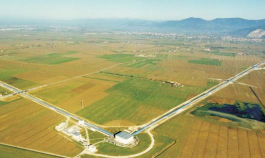Observatories gravitate together
DOI: 10.1063/1.4796399
Two leading ground-based gravitational wave detectors announced in mid-February that they are teaming up. The Laser Interferometer Gravitational-Wave Observatory (LIGO), with one interferometer in Louisiana and two in Washington State, and Virgo, an Italian–French facility located near Pisa, Italy, will mesh their data and data analysis. Money and management will remain separate.
Combining data from the two projects—three, counting Germany and the UK’s GEO600, which already has a cozy collaboration with LIGO—has several advantages, says Virgo spokesman Benoît Mours of CNRS’s high-energy and astroparticle research center in Annecy, France. “We will be able to get more information from a single source, such as location, because a signal will arrive at different times at our detectors. And we increase sky coverage and can better separate signal from noise. With a weak signal, that’s a real plus.”
So far the hunt for gravitational waves from inspiraling compacscodet binaries, pulsars, bursts of unknown origin, and stochastic background from the early universe has yielded only upper limits.
But that is expected to change after a nearly $200 million makeover of LIGO, to be completed in 2014, and next month’s debut of Virgo, which will likewise be followed by an upgrade. The resulting higher sensitivity “is what we need to start seeing signals on a regular basis,” says former LIGO spokesman Peter Saulson of Syracuse University. Publications will list as authors all 600 or so members from the allied projects.

Virgo, which starts hunting for gravitational waves next month, joins LIGO in a close alliance.
CNRS/INFN

More about the Authors
Toni Feder. One Physics Ellipse, College Park, Maryland 20740-3842 US . tfeder@aip.org





